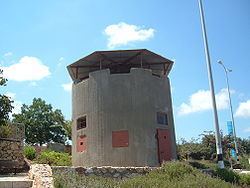 | ||
Similar | ||
Tegart's Wall was a barbed wire fence erected in May-June 1938 by British Mandatory authorities in the Upper Galilee near the northern border of the territory in order to keep militants from infiltrating from French-controlled Mandatory Lebanon and Syria to join the 1936–1939 Arab revolt in Palestine. With time the security system further included police forts, smaller pillbox-type fortified positions, and mounted police squads patrolling along it. It was described as an "ingenious solution for handling terrorism in Mandatory Palestine."
History
The wall, an early separation barrier, was built on the orders of Charles Tegart, adviser to the Palestine Government on the suppression of terrorism. In his first report, Tegart wrote that the border could not be defended along most of its length under the prevailing topographical conditions. The barrier was strung along the entire Palestine frontier at a cost of $450,000. It included a nine-foot barbed wire fence between Palestine and French-mandated Lebanon and Syria on the north and northeast. Before the fence was completed, "a band of Arab terrorists swooped down on a section of the fence...ripped it up and carted it across the frontier into Lebanon."
Five Tegart forts and twenty pillboxes were built along the route of the fence. Nevertheless, the infiltrators easily overcame the fence and evaded mobile patrols along the frontier road.
The barrier, which impeded both legal and illegal trade, angered local inhabitants on both sides of the border because it bisected pastures and private property. After the rebellion was suppressed in 1939, the wall was dismantled.
